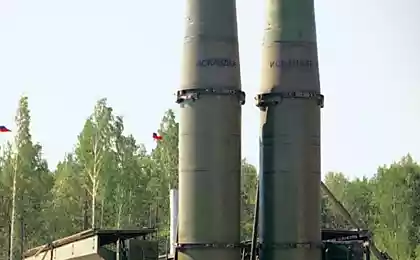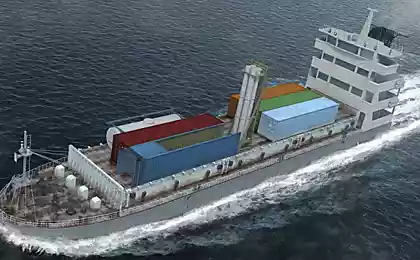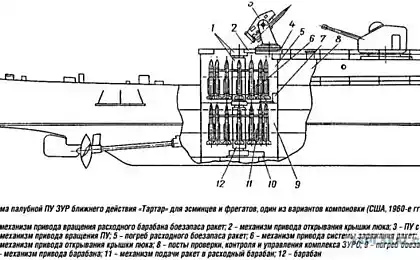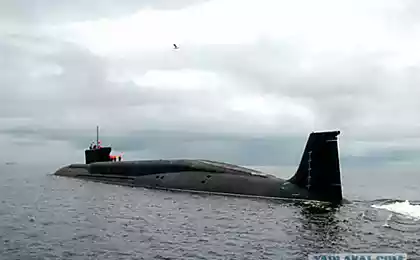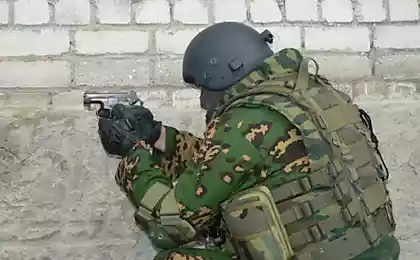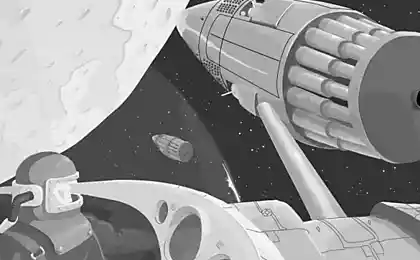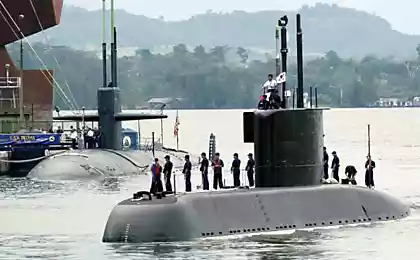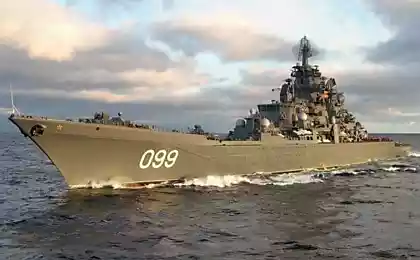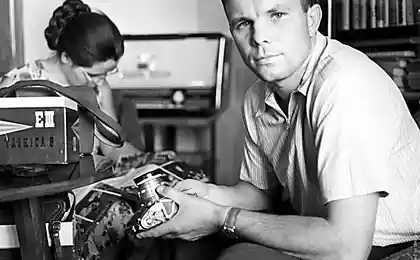1191
From Russian missiles now do not hide even the US aircraft carriers
Recently, the Pentagon chief Leon Panetta said the truism: "Every fifth-grader knows that the US aircraft carrier strike groups are not able to destroy any one of the existing powers of the world." Indeed, American AUG invulnerable because aircraft "sees" on any land (and sea) radar system. They will have time to "pinpoint" the enemy from the air to do with it what you want. However, we managed to find a way to "put a black mark" on the American fleet - from space. In the late 70s the USSR has created a marine space reconnaissance and target designation system "Legend", which could bring a missile on any ship in the world's oceans. Due to the fact that optical technology High resolution were then available, we had to run these satellites at very low orbit (400 km) and be powered by a nuclear reactor. The complexity of the energy schemes determined the fate of the program - in 1993, "Legend" has ceased to "cover" even half of the naval strategic directions, and in 1998 the last stop service unit. However, in 2008 the project was revived and is already in the new, more efficient physical principles. As a result, by the end of this year, Russia will be able to for three hours with an accuracy of 3 meters to destroy any US aircraft carrier anywhere in the world the United States made a winning bet on the carrier fleet - "chicken farm" with rocket safeguard destroyers become inaccessible and highly mobile floating armies. Even the powerful Soviet Navy had no hope to compete on equal terms with the US. Despite the existence of the USSR Navy submarines (NS ave. 675, Pr. 661 "Anchar" DPL ave. 671), missile cruisers, onshore RCC numerous navy missile boats, as well as numerous facilities ASM P-6, P -35, U-70, U-500, had no confidence in the guaranteed defeat AUG. Special combat units could not rectify the situation - the problem was in a safe horizon detection purposes, their selection and provide accurate target designation for flying up cruise missiles.
The use of aircraft for guidance RCC did not solve the problem: the ship's helicopter had limited opportunities, moreover, was very vulnerable to carrier-based aircraft. Scout Tu-95RTS, despite the excellent inclinations, was ineffective - the aircraft required many hours to arrive at a predetermined area of the oceans, and again became a scout an easy target for fast interceptor deck. Such inevitable factors as weather conditions, completely undermines the credibility of the Soviet military to the proposed system of targeting on the basis of the helicopter and reconnaissance aircraft. The solution was the only one - to monitor the situation in the oceans from space.

To work on the project the largest research centers in the country - Physics and Energy Institute and the Institute of Atomic Energy. AND IN. Kurchatov. Calculations orbital parameters were carried out under the guidance of Academician Keldysh. Parent organization became Design Bureau VN Chelomeya. The development of on-board nuclear power plant was conducted in OKB-670 (NGO "Red Star"). In early 1970, the Leningrad plant "Arsenal" has produced the first prototypes. Apparatus radar reconnaissance was adopted in 1975, and the satellite signals intelligence - in 1978. In 1983 he was adopted by the last component of the system - supersonic antiship missile P-700 "Granite».
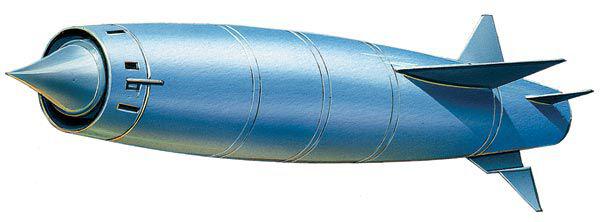
In 1982, a unified system has been tested in action. During the Falklands War, the data from the satellites allowed the command of the Soviet Navy to monitor operational and tactical situation in the South Atlantic, accurately calculate the action of the British Navy, and even up to a few hours to predict the time and location of the landing of British troops in the Falklands. The orbital group together with ship items receiving the information provided detection of ships and the issue of targeting missiles.
The first type of satellite CSS-P ("controlled satellite - passive" index Grau 17F17) is a set of electronic intelligence, created for the detection and direction finding objects with electromagnetic radiation. The second type of satellite US-A ("controlled satellite - active" index Grau 17F16) was equipped with side-scan radar bilateral providing all-weather detection and vsesutochnoe surface targets. Low operational orbit (which eliminates the use of bulky solar panels) and the need for a powerful and uninterrupted source of energy (solar panels could not work on the shady side of the Earth) have identified the type of on-board power supply - nuclear reactor BES-5 "Buk" heat output of 100 kW (electric power - 3 kW, the estimated time - 1,080 hours).
September 18, 1977 from Baikonur was successfully launched spacecraft "Kosmos-954" - an active satellite MKRTS "Legend". For a whole month, "Kosmos-954" has worked on the space orbit, along with the "Cosmos-252". October 28, 1977 the satellite suddenly ceased to be controlled by ground control services. All attempts to orient him were unsuccessful. Display the "graveyard orbit" also failed. At the beginning of January 1978 there was a depressurization of the instrument compartment of the spacecraft "Kosmos-954" is completely out of order and not responding to the Earth. It began uncontrolled decrease satellites with nuclear reactors on board.
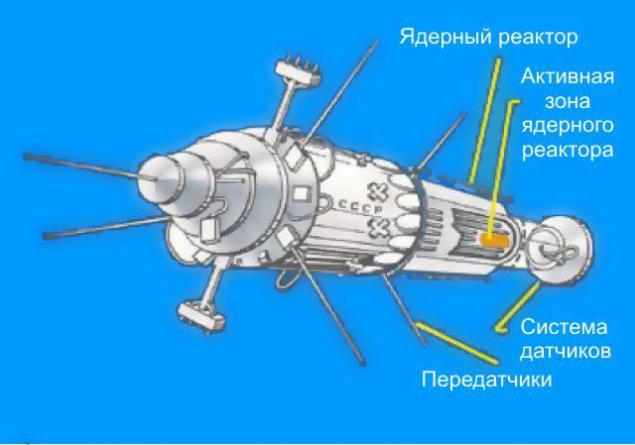
The Western world watched in horror at the night sky, expecting to see a shooting star's death. All we are discussing when and where to drop a flying reactor. "Russian Roulette" has begun. Early in the morning of January 24, "Cosmos-954" collapsed over the territory of Canada and covered with radioactive debris Alberta. Fortunately for Canadians, Alberta is a sparsely populated northern province, none of the local population has suffered. Needless to say, there was an international scandal, the Soviet Union paid symbolic compensation in the next three years refused to launch US-A. Nevertheless, in 1982, he repeated a similar accident on board the satellite "Cosmos-1402". At this time, the spacecraft safely drowned in the waves of the Atlantic. If the fall started 20 minutes earlier - "Kosmos-1402" would have landed in Switzerland.
Fortunately more serious accidents "flying Russian reactors" were recorded. In case of emergency situations reactors separated without incident and transferred to the "graveyard orbit". Total program "Maritime space reconnaissance and target designation system" was carried out 39 launches (including test) radar reconnaissance satellites US-A with nuclear reactors on board, 27 of them successful. As a result, US-A 80s reliably monitor surface situation in the oceans. The last launch of a spacecraft of this type took place March 14, 1988.
Currently, as part of a space grouping of the Russian Federation are only passive electronic reconnaissance satellites CSS-P. The last of them - the "Kosmos-2421" - was launched on June 25, 2006, and failed. According to official information, on board any small problems due to incomplete disclosure of solar panels.
During the chaos of the 90s and the under-funding of the first half of the 2000s "Legend" has ceased to exist - in 1993, "Legend" has ceased to "cover" even half of the naval strategic directions, and in 1998 was buried last active unit. However, without it, it was impossible to speak of any effective counteraction to the US Navy, not to mention the fact that we have become blind - military intelligence has remained without an eye, and the country's defense has deteriorated dramatically.

By the intensive care unit of reconnaissance and target back in 2006, when the government has instructed the Ministry of Defense to study the issue in terms of the use of new optical technology accurately detect. To work connected companies 12 125 industries, the working title - "Liana". In 2008 the project was ready crafted, and in 2009 hosted the first experimental launch of the experimental apparatus and excretion into the desired orbit. The new system is more versatile - because of the higher orbit, it can scan not only large objects in the ocean, that was able to Soviet "Legend", and any object up to 1 meter anywhere in the world. Precision has grown more than 100 times - up to 3 meters. And while no nuclear reactors that threaten the ecosystem of the Earth.
In 2013, the Russian Federal Space Agency and the Defense Ministry have completed the creation of an experimental orbit "Liana" and started to debug its systems. According to the plan by the end of this year, the system will work at 100%. It consists of four new radar reconnaissance satellites, which will be based at an altitude of about 1 thousand. Km above the planet's surface and constantly scan the ground, air and sea space in the presence of the enemy objects.
"Four satellites" Liana "- two" Peony "and two" Lotus "- will be in real time to detect enemy targets - airplanes, ships, cars. The coordinates of these objectives will be sent to the command post, which will create a virtual map of the real time. In case of war on these objects will be applied to precision strikes ", - explained the principle of the system representative of the General Staff.
Not without its "first pancake." "The first satellite" Lotus-S "index 14F138 had a number of shortcomings. After launching into orbit it revealed that it does not work nearly half-board systems. Therefore, we require the developer to bring the equipment up to the mind, "- said the representative of the Space Forces, which are now included in the aerospace defense. Experts explained that all deficiencies have been associated with the satellite flaws in the software of the satellite. "Our programmers completely reworked software suite and have to flash the first" Lotus ". Now it claims to have no war ", - told the Defense Ministry.
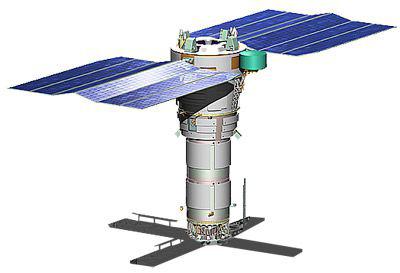
Another satellite system "Liana" launched into orbit in autumn 2013 - "Lotus-C" 14F145 that intercepts data, including talks enemy (electronic reconnaissance), and in 2014 into space will go a promising satellite radar reconnaissance " Pion-NCC '14F139, which is able to detect an object the size of a passenger car on any surface. Until 2015, "Liana" include one "Peony", so the system will expand the size of groups of up to four satellites. After reaching the current mode system "Liana" completely replace the outdated system "Legend - Celina." It is an order of magnitude increase the chances of the Russian Armed Forces to detect and defeat enemy targets.
--img6--
Source: expert.ru
The use of aircraft for guidance RCC did not solve the problem: the ship's helicopter had limited opportunities, moreover, was very vulnerable to carrier-based aircraft. Scout Tu-95RTS, despite the excellent inclinations, was ineffective - the aircraft required many hours to arrive at a predetermined area of the oceans, and again became a scout an easy target for fast interceptor deck. Such inevitable factors as weather conditions, completely undermines the credibility of the Soviet military to the proposed system of targeting on the basis of the helicopter and reconnaissance aircraft. The solution was the only one - to monitor the situation in the oceans from space.

To work on the project the largest research centers in the country - Physics and Energy Institute and the Institute of Atomic Energy. AND IN. Kurchatov. Calculations orbital parameters were carried out under the guidance of Academician Keldysh. Parent organization became Design Bureau VN Chelomeya. The development of on-board nuclear power plant was conducted in OKB-670 (NGO "Red Star"). In early 1970, the Leningrad plant "Arsenal" has produced the first prototypes. Apparatus radar reconnaissance was adopted in 1975, and the satellite signals intelligence - in 1978. In 1983 he was adopted by the last component of the system - supersonic antiship missile P-700 "Granite».

In 1982, a unified system has been tested in action. During the Falklands War, the data from the satellites allowed the command of the Soviet Navy to monitor operational and tactical situation in the South Atlantic, accurately calculate the action of the British Navy, and even up to a few hours to predict the time and location of the landing of British troops in the Falklands. The orbital group together with ship items receiving the information provided detection of ships and the issue of targeting missiles.
The first type of satellite CSS-P ("controlled satellite - passive" index Grau 17F17) is a set of electronic intelligence, created for the detection and direction finding objects with electromagnetic radiation. The second type of satellite US-A ("controlled satellite - active" index Grau 17F16) was equipped with side-scan radar bilateral providing all-weather detection and vsesutochnoe surface targets. Low operational orbit (which eliminates the use of bulky solar panels) and the need for a powerful and uninterrupted source of energy (solar panels could not work on the shady side of the Earth) have identified the type of on-board power supply - nuclear reactor BES-5 "Buk" heat output of 100 kW (electric power - 3 kW, the estimated time - 1,080 hours).
September 18, 1977 from Baikonur was successfully launched spacecraft "Kosmos-954" - an active satellite MKRTS "Legend". For a whole month, "Kosmos-954" has worked on the space orbit, along with the "Cosmos-252". October 28, 1977 the satellite suddenly ceased to be controlled by ground control services. All attempts to orient him were unsuccessful. Display the "graveyard orbit" also failed. At the beginning of January 1978 there was a depressurization of the instrument compartment of the spacecraft "Kosmos-954" is completely out of order and not responding to the Earth. It began uncontrolled decrease satellites with nuclear reactors on board.

The Western world watched in horror at the night sky, expecting to see a shooting star's death. All we are discussing when and where to drop a flying reactor. "Russian Roulette" has begun. Early in the morning of January 24, "Cosmos-954" collapsed over the territory of Canada and covered with radioactive debris Alberta. Fortunately for Canadians, Alberta is a sparsely populated northern province, none of the local population has suffered. Needless to say, there was an international scandal, the Soviet Union paid symbolic compensation in the next three years refused to launch US-A. Nevertheless, in 1982, he repeated a similar accident on board the satellite "Cosmos-1402". At this time, the spacecraft safely drowned in the waves of the Atlantic. If the fall started 20 minutes earlier - "Kosmos-1402" would have landed in Switzerland.
Fortunately more serious accidents "flying Russian reactors" were recorded. In case of emergency situations reactors separated without incident and transferred to the "graveyard orbit". Total program "Maritime space reconnaissance and target designation system" was carried out 39 launches (including test) radar reconnaissance satellites US-A with nuclear reactors on board, 27 of them successful. As a result, US-A 80s reliably monitor surface situation in the oceans. The last launch of a spacecraft of this type took place March 14, 1988.
Currently, as part of a space grouping of the Russian Federation are only passive electronic reconnaissance satellites CSS-P. The last of them - the "Kosmos-2421" - was launched on June 25, 2006, and failed. According to official information, on board any small problems due to incomplete disclosure of solar panels.
During the chaos of the 90s and the under-funding of the first half of the 2000s "Legend" has ceased to exist - in 1993, "Legend" has ceased to "cover" even half of the naval strategic directions, and in 1998 was buried last active unit. However, without it, it was impossible to speak of any effective counteraction to the US Navy, not to mention the fact that we have become blind - military intelligence has remained without an eye, and the country's defense has deteriorated dramatically.

By the intensive care unit of reconnaissance and target back in 2006, when the government has instructed the Ministry of Defense to study the issue in terms of the use of new optical technology accurately detect. To work connected companies 12 125 industries, the working title - "Liana". In 2008 the project was ready crafted, and in 2009 hosted the first experimental launch of the experimental apparatus and excretion into the desired orbit. The new system is more versatile - because of the higher orbit, it can scan not only large objects in the ocean, that was able to Soviet "Legend", and any object up to 1 meter anywhere in the world. Precision has grown more than 100 times - up to 3 meters. And while no nuclear reactors that threaten the ecosystem of the Earth.
In 2013, the Russian Federal Space Agency and the Defense Ministry have completed the creation of an experimental orbit "Liana" and started to debug its systems. According to the plan by the end of this year, the system will work at 100%. It consists of four new radar reconnaissance satellites, which will be based at an altitude of about 1 thousand. Km above the planet's surface and constantly scan the ground, air and sea space in the presence of the enemy objects.
"Four satellites" Liana "- two" Peony "and two" Lotus "- will be in real time to detect enemy targets - airplanes, ships, cars. The coordinates of these objectives will be sent to the command post, which will create a virtual map of the real time. In case of war on these objects will be applied to precision strikes ", - explained the principle of the system representative of the General Staff.
Not without its "first pancake." "The first satellite" Lotus-S "index 14F138 had a number of shortcomings. After launching into orbit it revealed that it does not work nearly half-board systems. Therefore, we require the developer to bring the equipment up to the mind, "- said the representative of the Space Forces, which are now included in the aerospace defense. Experts explained that all deficiencies have been associated with the satellite flaws in the software of the satellite. "Our programmers completely reworked software suite and have to flash the first" Lotus ". Now it claims to have no war ", - told the Defense Ministry.

Another satellite system "Liana" launched into orbit in autumn 2013 - "Lotus-C" 14F145 that intercepts data, including talks enemy (electronic reconnaissance), and in 2014 into space will go a promising satellite radar reconnaissance " Pion-NCC '14F139, which is able to detect an object the size of a passenger car on any surface. Until 2015, "Liana" include one "Peony", so the system will expand the size of groups of up to four satellites. After reaching the current mode system "Liana" completely replace the outdated system "Legend - Celina." It is an order of magnitude increase the chances of the Russian Armed Forces to detect and defeat enemy targets.
--img6--
Source: expert.ru




